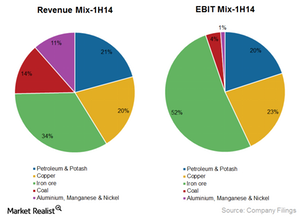BHP Billiton: A critical business overview
BHP Billiton (BHP) is a leading global diversified resources company and is one of the world’s largest major commodity producers.
March 24 2015, Updated 1:05 p.m. ET

BHP Billiton overview
BHP Billiton (BHP) is a leading global diversified resources company and is one of the world’s largest major commodity producers. Its commodities include iron ore, metallurgical and energy coal, oil and gas, copper, aluminum, manganese, uranium, nickel, and silver. The company has its headquarters in Melbourne, Australia.
BHP operates through 100 locations in 25 countries. The company was created when BHP and Billiton merged in June 2001.
BHP’s segments
BHP’s work is organized into five business units:
- petroleum and potash
- copper
- iron ore
- coal and aluminum
- manganese and nickel
BHP’s main focus is to own low-cost, long-life assets. In keeping with this focus, the company decided to spin off the assets that don’t meet this criteria into a separate company. Most of the de-merged assets were small compared to the “core” assets: iron ore, coal, copper, petroleum, and potash. The non-core assets contribute only 3% of the company’s overall earnings before interest, tax, depreciation, and amortization (or EBITDA), which is why BHP wants to instead focus on its four core commodities.
Peers
BHP competes against different players in each of its product segments. Overall, Rio Tinto (RIO) is its closest diversified peer. It operates in product segments like iron ore, aluminum, copper, diamonds, minerals, and energy.
Together, BHP and Rio Tinto contribute to 29.5% of the iShares MSCI Global Metals & Mining Producers ETF (PICK). The SPDR S&P Metals & Mining ETF (XME) also invests in metals and mining companies.
Vale (VALE) is less diversified. It operates out of Brazil and is the largest iron ore mining company in the world. Cliffs Natural Resources’ (CLF) international segments compete against seaborne iron ore and coal players, including BHP.
